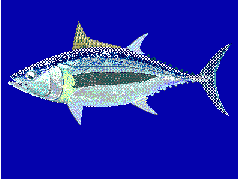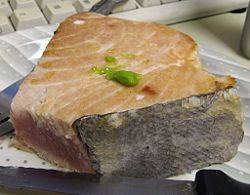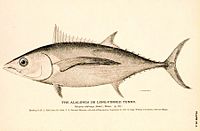Albacore
| Albacore | ||||||||||||||
|---|---|---|---|---|---|---|---|---|---|---|---|---|---|---|
 Albacore Tuna, Thunnus alalunga
| ||||||||||||||
| Scientific classification | ||||||||||||||
| ||||||||||||||
| Thunnus alalunga (Bonnaterre, 1788) |
The albacore (Thunnus alalunga) is a type of tuna in the family Scombridae. This species may also be called albacore fish, albacore tuna, bastard albacore, longfin, albies, pigfish, Pacific albacore, German bonito (but see bonito), longfin tuna, longfin tunny, or even just tuna. It is the only tuna species which may be marketed as "white meat tuna" in the United States.
It is found in the open waters of all tropical and temperate oceans, and the Mediterranean Sea. Lengths range up to 140 cm and weights up to 60 kg.
Albacore is a prized food, and albacore fishery is economically significant. Methods of fishing include pole and line, long-line fishing, trolling, and some purse seining. It is also sought after by sport fishers.
Albacore accumulates higher levels of mercury than other kinds of tuna, and some groups have urged testing and recall of canned albacore with high mercury levels. Long-line albacore are older fish and have accumulated more mercury than younger, troll-caught albacore. The U.S. Food and Drug Administration (FDA) advises women of childbearing age and children to limit their consumption of albacore tuna (chunk white canned tuna) and tuna steaks to 6 ounces per week or less. (See albatuna.com and wfoa-tuna.org and afrf.org for detailed info on the differences between catch methods and the nutritional benefits of troll-caught.)
The pectoral fins of the albacore are very long, as much as 30% of the total length. The dorsal spines are 11 to 14 in number, and well forward of the rays of the dorsal fin. The anterior spines are much longer, giving a concave outline to the spiny part of the dorsal fin.
Conservation status
The World Conservation Union (IUCN), has not re-assessed Albacore in over 10 years, and the last assessment given (from 1996) was "data deficient". This is due to lack of fishing for the fish past certain depths.[2] Assessments of the stocks of the North and South Atlantic from the same period showed them to be vulnerable and critically endangered stocks respectively, due to significant population reductions measured through an index of abundance and considering "actual or potential levels of exploitation".[1]
The Marine Stewardship Council advises that Albacore from the south Atlantic and south Pacific are fished at sustainable levels, but recommends choosing line (hand-line or pole and line) or troll-caught fish. The American Albacore Fishing Association Pacific fishery has begun an assessment process to be considered an environmentally responsible fishery.[3]
The Monterey Fish Market Seafood Sustainability Advisory list claims that fishery researchers generally agree that the North Pacific albacore population is a healthy stock at the current time. The list considers the north pacific albacore fishery to be "eco-friendly", in that there is very little by-catch and no impact on fishery habitat. Also, unlike some other tuna species, albacore do not usually swim with dolphins — and for this reason there is not a dolphin-associated albacore fishery anywhere in the world. [4]
SeaChoice ranks Albacore as a "best choice" for consumers, although notes some "moderate concerns" regarding the management effectiveness (in particular, no definitive survey of the albacore stock of the Indian Ocean fishery has taken place), and "moderate concern" over the fishing stock, especially regarding the North Atlantic albacore population, which the National Marine Fisheries Service (NMFS) considers overfished with overfishing still occurring. The southern Atlantic stock is not considered overfished. [5]
Other species called albacore
In some parts of the world, other species may be called "albacore":
- Blackfin tuna Thunnus atlantics (albacore)
- Yellowfin tuna Thunnus albacares (albacore, autumn albacore, yellowfinned albacore)
- Yellowtail amberjack Seriola lalandi (albacore)
- Kawakawa Euthynnus affinis (false albacore)
- Little tunny Euthynnus alletteratus (false albacore)
ReferencesISBN links support NWE through referral fees
- ↑ 1.0 1.1 Uozumi 1996. [1]. 2006 IUCN Red List of Threatened Species., World Conservation Union. Retrieved on 12 May 2006.
- ↑ Thunnus alalunga. Animal Diversity Web. Retrieved 2007-02-22.
- ↑ Tuna, albacore. FishOnline. Retrieved 2007-02-21.
- ↑ Our Advisory List. Monterey Fish Market. Retrieved 2007-02-21.
- ↑ Tuna: Albacore. Seachoice. Retrieved 2007-02-21.
External links
- Etymology of "albacore"
- FishBase info for albacore
- Communicating FDA advice on consumption of albacore tuna.
- Albacore by R. Michael Laurs and Ronald C. Dotson, 1992, retrieved January 19, 2006.
- GotMercury.Org, a mercury-in-fish calculator using FDA data and using the EPA's formula for safe exposure.
Gallery
Credits
New World Encyclopedia writers and editors rewrote and completed the Wikipedia article in accordance with New World Encyclopedia standards. This article abides by terms of the Creative Commons CC-by-sa 3.0 License (CC-by-sa), which may be used and disseminated with proper attribution. Credit is due under the terms of this license that can reference both the New World Encyclopedia contributors and the selfless volunteer contributors of the Wikimedia Foundation. To cite this article click here for a list of acceptable citing formats.The history of earlier contributions by wikipedians is accessible to researchers here:
The history of this article since it was imported to New World Encyclopedia:
Note: Some restrictions may apply to use of individual images which are separately licensed.



